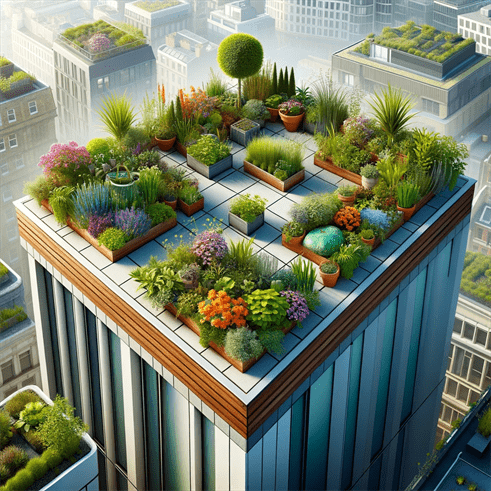Urban living often comes with the challenge of limited green space, but rooftop gardens present a creative solution to this dilemma. Transforming your rooftop into a garden not only provides a personal retreat in the urban landscape but also contributes to environmental sustainability.
This comprehensive guide will take you through the steps to create an enchanting rooftop garden, turning your urban space into a green paradise.

Embracing the Concept of Rooftop Gardening
Rooftop gardening is an innovative approach to urban greening, offering a way to utilize underused spaces to create beautiful, functional gardens.
These gardens can range from simple container arrangements to elaborate landscapes complete with large planters and outdoor living areas.
Assessing and Preparing Your Rooftop
Before starting, it’s crucial to assess the structural capacity of your rooftop. Consult with a structural engineer to ensure your roof can support the additional weight of soil, plants, and furniture.
Waterproofing and installing proper drainage are also essential to protect your building.
Designing Your Rooftop Garden
Designing a rooftop garden requires thoughtful planning. Consider aspects such as weight distribution, wind exposure, sun and shade areas, and accessibility.
Create a layout that includes various elements like seating areas, planters, and possibly even a small pond or water feature.
Selecting Suitable Containers and Planters
Containers and planters are fundamental components of rooftop gardens. Choose lightweight materials like fiberglass or resin to minimize weight load.
Ensure adequate drainage in all containers to prevent waterlogging, which can be detrimental to plant health.
Choosing the Right Plants
The plants you select should be suitable for the unique conditions of a rooftop setting.
Opt for wind and drought-resistant varieties. Hardy perennials, ornamental grasses, small shrubs, and certain annuals and herbs are excellent choices for rooftop gardens.
Soil and Nutrient Management
Good soil is the foundation of a healthy garden. Use a high-quality potting mix suitable for container gardening. Regularly enrich the soil with compost or organic fertilizers to provide your plants with the necessary nutrients for growth.
Implementing a Watering System
Rooftop gardens may require more frequent watering due to increased sun exposure and wind. Consider installing a drip irrigation system for efficient watering.
Collecting rainwater, if possible, is an eco-friendly watering solution.
Wind Protection and Microclimates
Rooftops are often subject to strong winds, which can damage plants. Utilize windbreaks such as trellises, screens, or taller plants to protect more sensitive varieties.
Creating microclimates with the strategic placement of plants and structures can also enhance plant growth.
Creating a Pollinator-Friendly Garden
Attracting pollinators like bees and butterflies can significantly benefit your rooftop garden. Incorporate a variety of flowering plants that provide nectar and pollen throughout the season.
Adding Personal Touches
Personalize your rooftop garden with unique features. Include comfortable seating, decorative lighting, and artistic elements to create an inviting atmosphere. Outdoor rugs, cushions, and accessories can add color and texture to your garden.
Year-Round Interest
Plan your garden so that it offers visual interest throughout the year. Evergreens, structural plants, and ornamental grasses can provide color and texture during the colder months.
Seasonal flowers and foliage changes also add dynamic elements to the garden.
Maximizing Space with Vertical Gardening
Incorporate vertical gardening to maximize space. Climbing plants, wall planters, and hanging baskets are great ways to add greenery without occupying floor space.
Safety Considerations
Safety is paramount in rooftop gardening. Ensure that railings are secure, pathways are clear, and any electrical installations are safely done.
Regular maintenance checks are crucial to keep your garden safe and enjoyable.
Embracing Sustainability
Aim for a sustainable rooftop garden. Use recycled or repurposed materials, opt for native plants, and practice organic gardening methods.
Rooftop gardens can play a significant role in urban sustainability, contributing to better air quality and reducing the heat island effect.
Your Rooftop, Your Oasis
Creating a rooftop garden is an exciting journey that not only transforms your living space but also contributes positively to the urban environment.
With careful planning, creative design, and sustainable practices, your rooftop can become a thriving garden that provides a much-needed connection to nature in the city.














